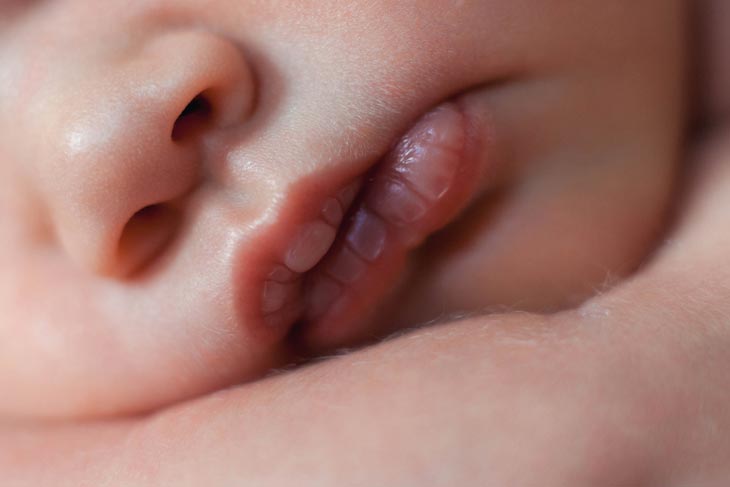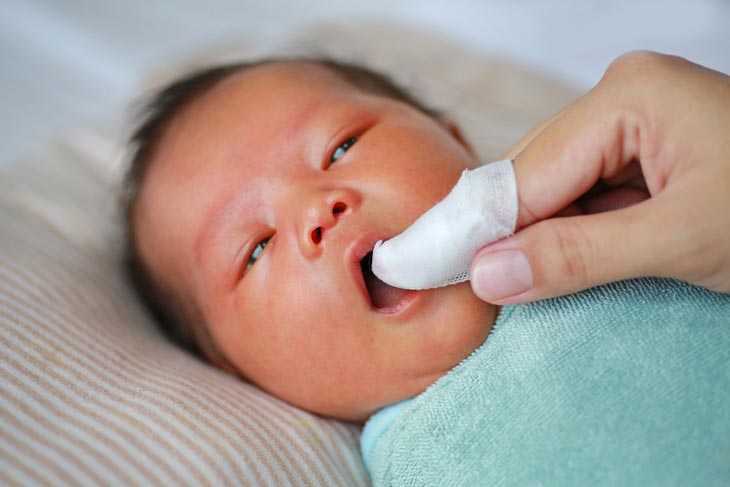It’s totally normal to worry about your baby’s feeding, especially in their first months. But what if the baby’s mouth shows some abnormal signs that might affect his eating?
If you notice your baby lips turning white or the baby blue around mouth after feeding, then take a deep breath.
Let us walk you through this article and explain different causes, risks of infections (maybe or not), signs, and preventions.
Why Are Baby Lips Turning White?

There are 2 types of causes: physical cause and chemical cause. Physically, it’s just due to prolonged sucking.
As for the chemical cause, the baby’s lips are white after nursing because of the white patches, which are called thrush – oral yeast infections.
1. Oral Thrush
Oral thrush manifests itself via white patches, multiplying on the sides, roofs, gums, and lips of a baby’s mouth. It can also spread to other areas such as the throat, tonsils, or gullet.
That’s pretty normal, as it happens to most newborns and toddlers who lactate for a long period of time.
So what causes oral thrush in the first place?
The development of candida (a yeast-like parasitic fungus that causes thrush) is no big deal, as it is controlled by one person’s immune system and its “good bacteria”.
But for babies at 6 months of age or fewer, their underdeveloped immune system can result in an overgrowth of the fungus.
Another reason is that your baby may have been given doses of baby antibiotics – which are great at fighting bacterial infections — but may also have killed some “good bacteria” unintentionally.
This means your baby’s natural gates or so-called immune system against the fungus are down, and the fungus will have a better chance to thrive and spread.
Not to mention, giving babies antibiotics partly contributes to the obesity risk.
If you a first-time mom, you should know signs of oral thrush in your baby before too late.
Here are some symptoms when a baby’s lips turn white after breastfeeding to watch out for:
- Babies cry or feel irritated while breastfeeding. The most obvious sign could be that they don’t feed as well as usual.
- White and odd-shaped patches appear on your little one’s tongue, gums, mouth roof, and so on.
- Cracked skin at both corners of the mouth.
- Yeast infection or diaper rash. Once the fungus passes through your baby’s digestive system, it can cause yeast diaper rash around the down-there area. You’d better learn how to put on a diaper correctly to ease your baby’s rash.
- Some signs on the mother’s body. If the mother has itchy, cracked nipples, or worse pain than expected, it could imply that you have oral thrush transferred from your baby’s mouth to your breasts during breastfeeding.
2. Milk Residue
Another symptom that is similar to oral thrush is milk residue. Due to their similar appearance, it can be confusing to distinguish between the two.
Milk residue is sometimes seen after a newborn is breastfed because of its low level of saliva production.
Try using a warm and wet piece of cloth to wipe around your baby’s mouth and lip area. If the white coating comes off easily, it is milk residue.
In contrast, suppose they are signs of oral thrush. Any effort to try to wipe away the white cottage cheese-like patches might leave red spots or cause bleeding in your baby.
Signs of milk residues around your baby’s lips
Newborn babies spend most of their first months of life sucking, about 8-12 times a day. So, little blisters and some peels in the middle part of the mouth appear.
But these signs will go away every week or so as long as your baby with lip blisters doesn’t turn all white and discolor in the mouth for too long. Then, your baby should be fine.
Therefore, signs of milk residue aren’t permanent or worth concern. The white spots on baby lips will quickly come off once your baby’s digestive system works better or he starts eating solid food.
What To Do When My Baby Lips Turning White?
Contact A Doctor
If your baby is suffering from oral thrush, parents must see their healthcare provider for medical advice if the thrush doesn’t come off for about two weeks.
A doctor will examine the infected child to prescribe some kinds of antifungal medication for babies and moms.
Moms should also apply gel to their nipples, areola, and breasts from time to time they breastfeed to prevent reinfection.
Further Actions To Prevent Fungal Infection
To help prevent the growth of fungal infection or reinfection, parents should include the following steps in their baby’s daily hygiene :
- Clean the baby white lips after feeding – at least to clean off dried drops of breast milk
- Use clean water to wash and sterilize feeding equipment such as milk bottles, breast pumps, and accessories (especially for bottle-fed babies)
- Wash and iron towels, clothing of babies as well as bras and clothes of moms
- Keep pumped breast milk in the refrigerator
- Clean and keep the breast dry after every feed
- Changing nursing pads frequently, not only when they get wet
- Apply anti-yeast cream or gel around your breast (but only with a doctor’s prescription!)
- Remember to check your baby’s mouth and coated tongue occasionally.
- Notice your baby’s behaviors with symptoms like decreased sucking, reduced breast milk intake, the occurrence of fever, bleeding in the mouth, very dry mouth, severe pain, and crying
The Key Takeaway

In this article, we have walked through the possible causes of a baby lips turning white, including physical and chemical causes.
We also give out some symptoms and how to get rid off antifungal treatment.
As for healthy breastfed infants, neither is serious, though oral thrush in babies can lead to some passing itchy discomfort or irritation for babies – and for you, moms!
So if the signs of infection persist for longer than you expect, don’t forget to visit the pediatrician.
If you have any questions or need help with breastfed babies, please reach out to us.
We are happy to help!
